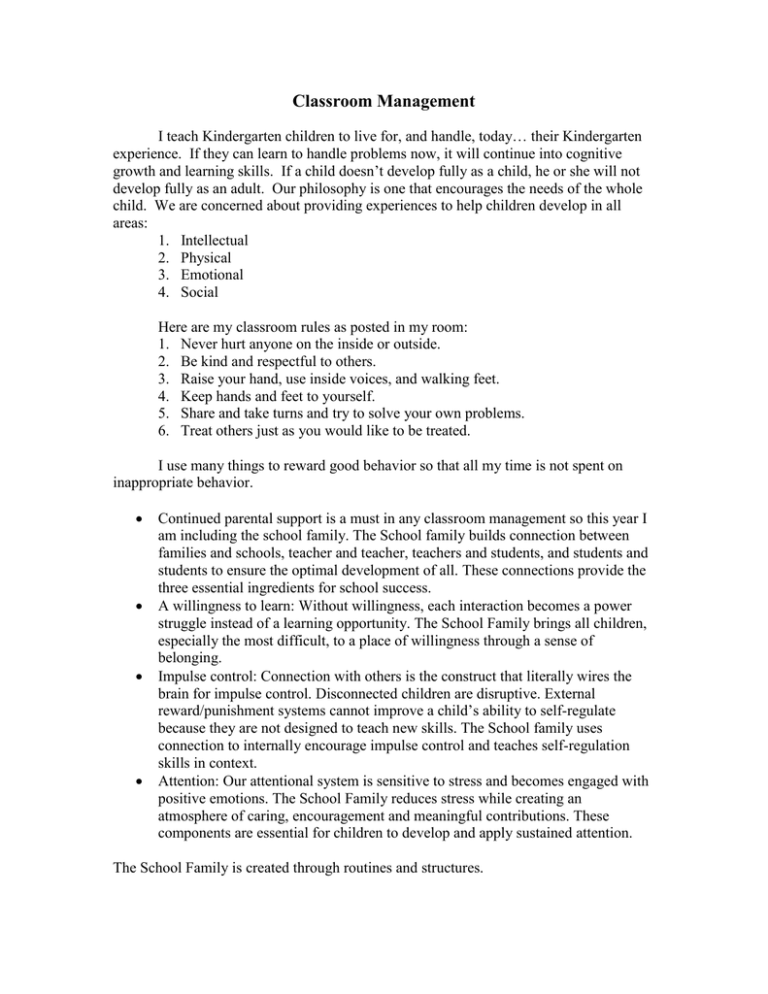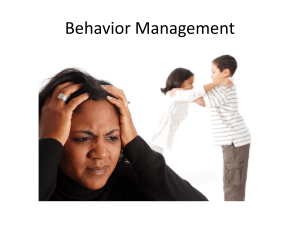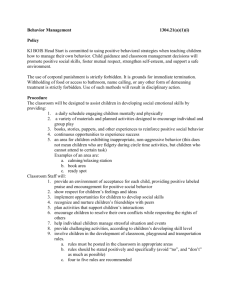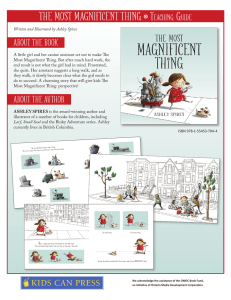Classroom Management
advertisement

Classroom Management I teach Kindergarten children to live for, and handle, today… their Kindergarten experience. If they can learn to handle problems now, it will continue into cognitive growth and learning skills. If a child doesn’t develop fully as a child, he or she will not develop fully as an adult. Our philosophy is one that encourages the needs of the whole child. We are concerned about providing experiences to help children develop in all areas: 1. Intellectual 2. Physical 3. Emotional 4. Social Here are my classroom rules as posted in my room: 1. Never hurt anyone on the inside or outside. 2. Be kind and respectful to others. 3. Raise your hand, use inside voices, and walking feet. 4. Keep hands and feet to yourself. 5. Share and take turns and try to solve your own problems. 6. Treat others just as you would like to be treated. I use many things to reward good behavior so that all my time is not spent on inappropriate behavior. Continued parental support is a must in any classroom management so this year I am including the school family. The School family builds connection between families and schools, teacher and teacher, teachers and students, and students and students to ensure the optimal development of all. These connections provide the three essential ingredients for school success. A willingness to learn: Without willingness, each interaction becomes a power struggle instead of a learning opportunity. The School Family brings all children, especially the most difficult, to a place of willingness through a sense of belonging. Impulse control: Connection with others is the construct that literally wires the brain for impulse control. Disconnected children are disruptive. External reward/punishment systems cannot improve a child’s ability to self-regulate because they are not designed to teach new skills. The School family uses connection to internally encourage impulse control and teaches self-regulation skills in context. Attention: Our attentional system is sensitive to stress and becomes engaged with positive emotions. The School Family reduces stress while creating an atmosphere of caring, encouragement and meaningful contributions. These components are essential for children to develop and apply sustained attention. The School Family is created through routines and structures. I believe in positive discipline, redirection, and time-out. I teach and model appropriate behavior by practice, practice, practice. I let the children know what I like about them, such as, “I like the way ______ lined up so quietly or “I like the way _____ remembered to raise her hand.” I praise and reward appropriate behavior immediately and I always try to emphasize the positive. I reinforce the appropriate behavior and make the atmosphere in my classroom a positive one. I stress the use of gift words such as “please”, “thank you”, “excuse me”, and “I’m sorry”. I, myself, use gift words. I believe kindness and thoughtfulness are contagious. I must first set the example. I try to be proactive not reactive. The first month will set the tone for the rest of the year. As exhausting as it may seem, if you spend the first month modeling and practicing appropriate classroom behaviors, it will pay off. I make the class rules clear and simple, and the consequences for misbehavior are clear, logical, and consistent. We start each day with a saying. I ask, “Who’s terrific” and the children respond, “We are”, and then I ask, “And what else are we” they say, “Magnificent!” I show them our visual cards – magnificent manners, stop sign, time-out, or a phone. Everyone starts the day with magnificent manners. We end the day with our “terrific” and “magnificent” saying. I first discipline a child by redirecting his/her behavior and activity, rather than punishing them. I give choices, when appropriate, and communicate non-verbally, as well (facial expressions, actions, tone of voice, hugs, etc.). Secondly, I use time-out. If this becomes repetitious, I keep an anecdotal record of significant and specific facts to be used at parent conferences. After having a parent conference I may suggest placing a child on a behavior chart, where they are responsible for their actions on a daily basis. The parents are responsible for a reward or punishment at the end of each week. I may also include the principal or counselor if behavior does not improve. I am consistent in my expectations and demands of children. I establish routines in the classroom so they will know what to expect and can handle themselves in these situations. Discipline is necessary, but patience and love will accomplish more than anger.







